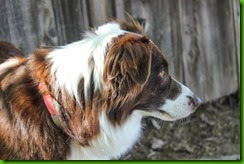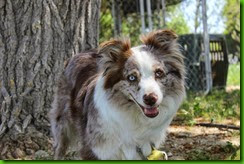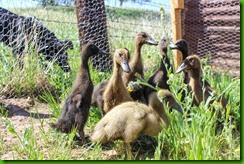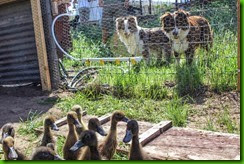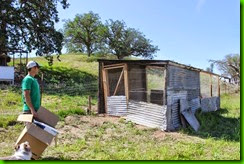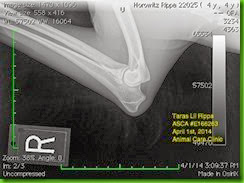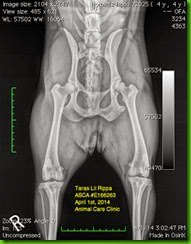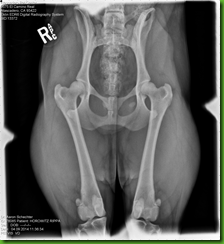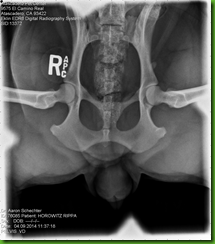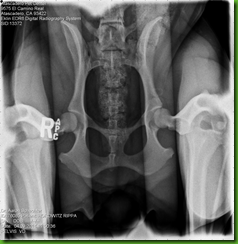This afternoon, I loaded Rippa up and we paid Shannon and Dustin Wood’s little spread in Atascadero, pretty much on the same road I use to get to Stephanie’s sheep rentals, just the opposite direction. Highway 41 is the big win in stockdog land.
I’m still feeling out how to approach the Woods’ lessons. They’re pretty open to me just doing my thing, but also super psyched to help me out and I’m trying to learn when to do my thing and when to take their advice – my thought is generally to listen to what they have to say, give it a try a couple times and I or the dog aren’t getting it, to go to what we know and ponder it. I think it’s working.
For example, Dustin had just built a round pen on his property (a dang fine one, by the way – post-holes dug and strung tight) and he says since they put it up, they’ve been using it every day. They like to warm their dogs up on it with their goats before putting them on cattle, and work on fundamentals.
Rippa and I haven’t been in a round pen in forever because of how Stephanie’s set up is, so we gave it a go, trying some outrun training handling advice but not getting so far so I went back to what she and I know well. Basically, again, is that the message is, is that I’ve been lazy.
With Fury, who naturally took her outruns pretty easy from what I remember, I never really had to worry about the finesse of starting them (for example, laying them down with their shoulder to the stock so they’re facing the way you want them to run), and so with Rippa, who I had had so much trouble starting in the first place, I have been letting just laydown facing them. No more. The Woods got on me about consistently asking for it and it would come. Good. Thing #1 to work on. Okay.
I should also note that working with them, with their dogs, I feel like the laziest trainer ever – their dogs take commands. Rippa takes the suggestion and I have to handle her harder. Partly, Rippa’s never been fast on the response during stock and I was happy to get what I got, and partly I am being lazy. There’s no reason I can’t get the same level of obedience out of her at this point, so I need to start working on my expectations of her trained behaviors. She’ll take ten feet to down, five feet to stop, and a while to “get back” or take her flanks. I need it now and I need to remember to make sure I get it now. It will help her outruns, too, if I an get her to stop and take her flanks. Thing #2 to work on.
Shannon talks to me about how I really need to train Rippa to respect the stick. She shows me with her own dog on a leash how if she points the stick at her dog (off stock), she’ll immediately turn her shoulder and try to get out of her space. I take the stick and poke at my dog, who looks inquisitively. We laugh. This is a really big point to me because when I worked both my dogs, I saw the stick as the enforcer and direction giver, and both Stephanie and the Woods see it as a little something more. I’m not sure I’ve seen Kathy Warren do the kind of stick ground work my BC people have suggested, but I may just not have been “seeing it” back when I was regularly taking lessons. Either way, thing #3 to work on.
We then moved into the cattle. They’d recently lost one of their Holstein heifers so picked up some replacement beef calves at the sale. Dustin said they hadn’t really been worked or dog broke yet so if we had to separate them out, he would. Well, no worries there. Rippa went right to them this time and got to work and they stayed just fine with the dairy cattle, with one red heifer seeming to always get herself out and chased back in – but I’d also say that she was also doing that because Rippa was too tight and pushing her out to start.
I started Rippa by just having her walk up their heels to keep her easy and cranked down (because Rippa is PSYCHED to actually WORK CATTLE) and once she started lifting them off the fence, we started the real training. The Woods’ have a lot of panels set up in their arena for finite obstacle work and to use to help teach the dogs to work in that kind of pressure, so I was able to use the panel to send Rippa out wider than I could without them. Once she figured that trick out, we had things pretty much dialed to lift them and fetch them to me.
Despite me starting her at the heels, Shannon observed that I should send her to the heads, and so I did, pushing her back after they turned. The one time I didn’t was the one time the fetch didn’t work out, so I learned a really good lesson there for my dog – despite her early starts being more heel work, she’s got big head instinct and to let her use that to feel in control.
The other thing that the Woods taught me was something I definitely wouldn’t have thought about . . . what happens when your group divides? In the beginning and occasionally toward the end of the lessons, one or two of the cattle would break off. This blows Rippa’s mind because she has a really strong sense of group but she’s also a bit insecure about working without me at a distance on the cattle (and I mentioned this is an issue on bigger distances with the sheep, too). She doesn’t know whether to come into me with the lots of cattle or to go get the ones she wants to. So Dustin told me, hey, if she has a group handled, you go to the other one. Doing that makes her feel secure and she’ll think better and just bring the cattle over, which she did. In the same vein, if I have a group handled and one lone cow, if I want her to bring that cow to the group, just walk up to the cow without saying anything to her and she’ll go pick it up and then I can walk back to the group. Generally you want to follow the “bring the many to the one” rule I like to live by, but if you have a relatively easy straggler, man, that works so well.
Well, it works so well if your dog has the instinct and power to do it, which, hey, sparkle, mine does.
When we finished up, Dustin was very effusive about her, “She did really, really, really, good. That was really nice. By the end there she was getting them out of the corner, biting them where she should be, and 100% better than the first time in there today and way better than last time you were here.”
That means a lot coming from them, as they’ve got some very, very fine dogs and their handling is beautiful, quiet, and confident.
Rippa’s improvement is pretty in keeping with how it’s been with her. Once she gets it (or I do), she gets it pretty thoroughly. Having done what we did in there with half unbroke calves and only our second time on cattle in almost a year . . . I can confidently say we’d get through an ASCA started course, no problem. Maybe not get the highest score out there yet, but like her mother, she’s definitely more a cow dog. All that power and grip she wants to use on the sheep and goats stops being quite as stress-gratuitous on cattle and she settles down really easy and reads her stock.
No problems walking up on their heads if the cattle we standing, lifting out of corners patiently, lifting off of fence panels. It was pretty dang awesome.
And it looks like I have a standing weekly date with them if we’re both available. Can’t wait to learn more. Better get started on that ground work.
